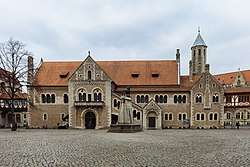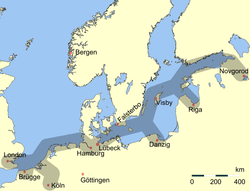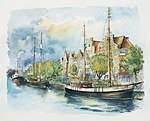Braunschweig
Braunschweig (German pronunciation: [ˈbʁaʊnʃvaɪk] (![]()
Brunswick Braunschweig | |
|---|---|
View over Braunschweig | |
 Flag  Coat of arms | |
Location of Brunswick within Lower Saxony  | |
 Brunswick 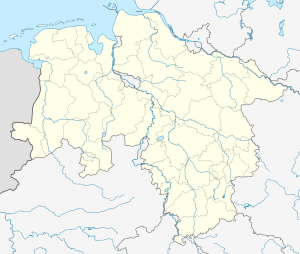 Brunswick | |
| Coordinates: 52°16′N 10°31′E | |
| Country | Germany |
| State | Lower Saxony |
| District | Urban district |
| Founded | 9th century |
| Subdivisions | 19 boroughs |
| Government | |
| • Lord Mayor | Ulrich Markurth (SPD) |
| Area | |
| • City | 192.13 km2 (74.18 sq mi) |
| Elevation | 75 m (246 ft) |
| Population (2018-12-31)[1] | |
| • City | 248,292 |
| • Density | 1,300/km2 (3,300/sq mi) |
| • Metro | 1,150,000[2] |
| Time zone | CET/CEST (UTC+1/+2) |
| Postal codes | 38100–38126 |
| Dialling codes | 0531, 05307, 05309, 05300 |
| Vehicle registration | BS |
| Website | Braunschweig.de |
A powerful and influential centre of commerce in medieval Germany, Braunschweig was a member of the Hanseatic League from the 13th until the 17th century. It was the capital city of three successive states: the Principality of Brunswick-Wolfenbüttel (1269–1432, 1754–1807, and 1813–1814), the Duchy of Brunswick (1814–1918), and the Free State of Brunswick (1918–1946).
Today, Braunschweig is the second-largest city in Lower Saxony and a major centre of scientific research and development.[4]
History
Foundation and early history
The date and circumstances of the town's foundation are unknown. Tradition maintains that Braunschweig was created through the merger of two settlements, one founded by Brun(o), a Saxon count who died in 880, on one side of the River Oker – the legend gives the year 861 for the foundation – and the other the settlement of a legendary Count Dankward, after whom Dankwarderode Castle ("Dankward's clearing"), which was reconstructed in the 19th century, is named.[5][6] The town's original name of Brunswik is a combination of the name Bruno and Low German wik (related to the Latin vicus), a place where merchants rested and stored their goods. The town's name, therefore, indicates an ideal resting place, as it lay by a ford across the Oker River. Another explanation of the city's name is that it comes from Brand, or burning, indicating a place which developed after the landscape was cleared through burning.[7] The city was first mentioned in documents from the St. Magni Church from 1031, which give the city's name as Brunesguik.[6]
Middle Ages and early modern period

| Year | Pop. | ±% |
|---|---|---|
| 1330 | 16,000 | — |
| 1550 | 16,000 | +0.0% |
| 1671 | 15,500 | −3.1% |
| 1758 | 22,500 | +45.2% |
| 1788 | 26,000 | +15.6% |
| 1811 | 27,600 | +6.2% |
| 1830 | 35,300 | +27.9% |
| 1849 | 39,000 | +10.5% |
| 1880 | 75,000 | +92.3% |
| 1890 | 100,000 | +33.3% |
| 1900 | 128,200 | +28.2% |
| 1925 | 146,900 | +14.6% |
| 1939 | 196,068 | +33.5% |
| 1950 | 223,767 | +14.1% |
| 1975 | 269,900 | +20.6% |
| 1989 | 253,794 | −6.0% |
| 2004 | 239,921 | −5.5% |
| 2010 | 248,867 | +3.7% |
| 2015 | 252,768 | +1.6% |
Up to the 12th century, Braunschweig was ruled by the Saxon noble family of the Brunonids, then, through marriage, it fell to the House of Welf. In 1142, Henry the Lion of the House of Welf became duke of Saxony and made Braunschweig the capital of his state (which, from 1156 on, also included the Duchy of Bavaria). He turned Dankwarderode Castle, the residence of the counts of Brunswick, into his own Pfalz and developed the city further to represent his authority. Under Henry's rule, the Cathedral of St. Blasius was built and he also had the statue of a lion, his heraldic animal, erected in front of the castle. The lion subsequently became the city's landmark.
Henry the Lion became so powerful that he dared to refuse military aid to the emperor Frederick I Barbarossa, which led to his banishment in 1182. Henry went into exile in England. He had previously established ties to the English crown in 1168, through his marriage to King Henry II of England's daughter Matilda, sister of Richard the Lionheart.[8] However, his son Otto, who could regain influence and was eventually crowned Holy Roman Emperor, continued to foster the city's development.
During the Middle Ages, Braunschweig was an important center of trade, one of the economic and political centers in Northern Europe and a member of the Hanseatic League from the 13th century to the middle of the 17th century.[9] By the year 1600, Braunschweig was the seventh largest city in Germany.[10] Although formally one of the residences of the rulers of the Duchy of Brunswick-Lüneburg, a constituent state of the Holy Roman Empire, Braunschweig was de facto ruled independently by a powerful class of patricians and the guilds throughout much of the Late Middle Ages and the Early modern period. Because of the growing power of Braunschweig's burghers, the Princes of Brunswick-Wolfenbüttel, who ruled over one of the subdivisions of Brunswick-Lüneburg, finally moved their Residenz out of the city and to the nearby town of Wolfenbüttel in 1432.[11] The Princes of Brunswick-Wolfenbüttel didn't regain control over the city until the late 17th century, when Rudolph Augustus, Duke of Brunswick-Lüneburg, took the city by siege.[12] In the 18th century Braunschweig was not only a political, but also a cultural centre. Influenced by the philosophy of the Enlightenment, dukes like Anthony Ulrich and Charles I became patrons of the arts and sciences. In 1745 Charles I founded the Collegium Carolinum, predecessor of the Braunschweig University of Technology, and in 1753 he moved the ducal residence back to Braunschweig. With this he attracted poets and thinkers such as Lessing, Leisewitz, and Jakob Mauvillon to his court and the city.[13] Emilia Galotti by Lessing and Goethe's Faust were performed for the first time in Braunschweig.[14]
19th century
In 1806, the city was captured by the French during the Napoleonic Wars and became part of the short-lived Napoleonic Kingdom of Westphalia in 1807. The exiled duke Frederick William raised a volunteer corps, the Black Brunswickers, who fought the French in several battles.[15]
After the Congress of Vienna in 1815, Braunschweig was made capital of the reestablished independent Duchy of Brunswick, later a constituent state of the German Empire from 1871. In the aftermath of the July Revolution in 1830, in Brunswick duke Charles II was forced to abdicate. His absolutist governing style had previously alienated the nobility and bourgeoisie, while the lower classes were disaffected by the bad economic situation. During the night of 7–8 September 1830, the ducal palace in Braunschweig was stormed by an angry mob, set on fire, and destroyed completely.[16] Charles was succeeded by his brother William VIII. During William's reign, liberal reforms were made and Brunswick's parliament was strengthened.[17]
During the 19th century, industrialisation caused a rapid growth of population in the city, eventually causing Braunschweig to be for the first time significantly enlarged beyond its medieval fortifications and the River Oker.[18] On 1 December 1838, the first section of the Brunswick–Bad Harzburg railway line connecting Braunschweig and Wolfenbüttel opened as the first railway line in Northern Germany, operated by the Duchy of Brunswick State Railway.[19][20]
Early to mid-20th century

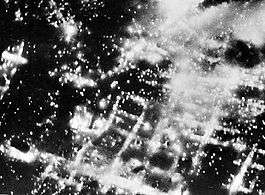
On 8 November 1918, at the end of World War I, a socialist workers' council forced Duke Ernest Augustus to abdicate.[21][22] On 10 November, the council proclaimed the Socialist Republic of Brunswick under one-party government by the Independent Social Democratic Party of Germany (USPD); however, the subsequent Landtag election on 22 December 1918 was won by the Social Democratic Party of Germany (MSPD), and the USPD and MSPD formed a coalition government.[23] An uprising in Braunschweig in 1919, led by the communist Spartacus League, was defeated when Freikorps troops under Georg Ludwig Rudolf Maercker took over the city on order of the German Minister of Defence, Gustav Noske.[24][25] An SPD-led government was subsequently established; in December 1921, a new constitution was approved for the Free State of Brunswick, now a parliamentary republic within the Weimar Republic, again with Braunschweig as its capital.[26]
After the Landtag election of 1930, Brunswick became the second state in Germany where the Nazis participated in government, when the National Socialist German Workers' Party (NSDAP) formed a coalition government with several conservative and right-wing parties.[27] With the support of Dietrich Klagges, Brunswick's minister of the interior, the NSDAP organized a large SA rally in Braunschweig. On 17–18 October 1931, 100,000 SA stormtroopers marched through the city, street fights between Nazis, socialists, and communists left several dead or injured.[28] On 25 February 1932, the state of Brunswick granted Adolf Hitler German citizenship to allow him to run in the 1932 German presidential election.[29] In Braunschweig, Nazis carried out several attacks on political enemies, with the acquiescence of the state government.[30]
After the Nazi seizure of power in 1933, several state institutions were placed in Braunschweig, including the Luftfahrtforschungsanstalt in Völkenrode, the Hitler Youth Academy for Youth Leadership,[31] and the SS-Junkerschule Braunschweig.[32] With the Reichswerke Hermann Göring in Salzgitter and the Stadt des KdF-Wagens, as well as several factories in the city itself (including Büssing and the Volkswagenwerk Braunschweig), the Braunschweig region became one of the centres of the German arms industry.[33]
During the Second World War, Braunschweig was an Untergebiet Hauptquartier ("Sub-Area Headquarters") of Wehrkreis XI ("Military District XI"),[34] and was the garrison city of the 31st Infantry Division that took part in the invasions of Poland, Belgium, and France, largely being destroyed during its retreat following the invasion of Russia. In this period, thousands of Eastern workers were brought to the city as forced labor,[35] and in the 1943–1945 period at least 360 children taken away from such workers died in the Entbindungsheim für Ostarbeiterinnen ("Maternity Ward for Eastern Workers").[36]
In 1944, a subcamp of the concentration camp Neuengamme was established in Braunschweig. Hundreds of prisoners, mostly Jews, lived in brutal conditions and hundreds died from hunger, disease, and overwork. Piera Sonnino, an Italian author, writes of her imprisonment in that camp in her book, This Has Happened, published in English in 2006 by MacMillan Palgrave.
The Allied air raid on October 15, 1944, destroyed most of the city's churches, and the Altstadt (old town), the largest homogeneous ensemble of half-timbered houses in Germany.[37] The city's cathedral, which had been converted to a Nationale Weihestätte (national shrine) by the Nazi government, still stood.[38]
Postwar period to the 21st century
Small sections of the city survived Allied bombing, so remain to represent its distinctive architecture.[39] The cathedral was restored to its function as a Protestant church.[40]
Politically, after the war, the Free State of Brunswick was dissolved by the Allied occupying authorities, Braunschweig ceased to be a capital, and most of its lands were incorporated in the newly formed state of Lower Saxony.[41]
During the Cold War, Braunschweig, then part of West Germany, suffered economically due to its proximity to the Iron Curtain. The city lost its historically strong economic ties to what was then East Germany; for decades, economic growth remained below and unemployment stayed above the West German average.[42]
On 28 February 1974, as part of a district reform in Lower Saxony, the rural district of Braunschweig, which had surrounded the city, was disestablished. The major part of the former district was incorporated into the city of Braunschweig, increasing its population by roughly 52,000 people.[43]
In the 1990s, efforts increased to reconstruct historic buildings that had been destroyed in the air raid. The façade of the Braunschweiger Schloss was rebuilt, and buildings such as the Alte Waage (originally built in 1534) now stand again.[44][45]
Demographics
Population development
As of 2015, the population of Braunschweig was 252,768.[46] Today Braunschweig is among the twenty German cities found to be most attractive to young people between the ages of 25 and 34, leading to an influx of younger residents.[47]
Religion
In 2015, 91,785 people or 36.3% of the population were Protestant and 34,604 (13.7%) people were Roman Catholic; 126,379 people (50.0%) either adhered to other denominations or followed no religion.[46]
Immigration
A total of 64,737 of Braunschweig's residents, including German citizens, had an immigrant background in 2015 (25.6% of the total population).[46] Among those, 25,676 were non-German citizens (10.2%);[46] the following table lists up the largest minority groups:[48]
| Rank | Nationality | Population (2024) |
|---|---|---|
| 1 | 4,899 | |
| 2 | 3,568 | |
| 3 | 1,405 | |
| 5 | 1,232 | |
| 6 | 691 | |
| 7 | 622 | |
Main sights
- The Burgplatz (Castle Square), comprising a group of buildings of great historical and cultural significance: the Cathedral (St Blasius, built at the end of the 12th century), the Burg Dankwarderode (Dankwarderode Castle) (a 19th-century reconstruction of the old castle of Henry the Lion), the Neo-Gothic Town Hall (built in 1893–1900), as well as some picturesque half-timbered houses, such as the Gildehaus (Guild House), today the seat of the Craftsman's Association. In the centre of the square stands a copy of the Burglöwe (Brunswick Lion), a Romanesque statue of a Lion, cast in bronze in 1166. The original statue can be seen in the museum of Dankwarderode Castle. Today the lion has become the true symbol of Braunschweig.
- The Altstadtmarkt ("Old Town market"), surrounded by the Old Town town hall (built between the 13th and the 15th centuries in Gothic style), and the Martinikirche (Church of Saint Martin, from 1195), with important historical houses including the Gewandhaus (the former house of the drapers' guild, built sometime before 1268) and the Stechinelli-Haus (built in 1690) and a fountain from 1408.
- The Kohlmarkt ("coal market"[49]), a market with many historical houses and a fountain from 1869.
- The Hagenmarkt ("Hagen market"), with the 13th-century Katharinenkirche (Church of Saint Catherine) and the Heinrichsbrunnen ("Henry the Lion's Fountain") from 1874.
- The Magniviertel (St Magnus' Quarter), a remainder of ancient Braunschweig, lined with cobblestoned streets, little shops and cafés, centred around the 13th-century Magnikirche (St Magnus' Church). Here is also the Rizzi-Haus, a highly distinctive, cartoonish office building designed by architect James Rizzi for the Expo 2000.
- The Romanesque and Gothic Andreaskirche (Church of Saint Andrew), built mainly between the 13th and 16th centuries with stained glass by Charles Crodel. Surrounding the church are the Liberei, the oldest surviving freestanding library building in Germany,[50][51] and the reconstructed Alte Waage.
- The Gothic Aegidienkirche (Church of Saint Giles), built in the 13th century, with an adjoining monastery, which is today a museum.
- The Staatstheater (State Theatre), newly built in the 19th century, goes back to the first standing public theatre in Germany, founded in 1690 by Duke Anthony Ulrich.
- The ducal palace of Braunschweig was bombed in World War II and demolished in 1960. The exterior was rebuilt to contain a palace museum, library and shopping centre, which opened in 2007.
- The baroque palace Schloss Richmond ("Richmond Palace"), built between 1768 and 1769 with a surrounding English garden for Princess Augusta of Great Britain, wife of Charles William Ferdinand, Duke of Brunswick-Wolfenbüttel, to remind her of her home in England.
- Riddagshausen Abbey (German: Kloster Riddagshausen), a former Cistercian monastery, with the surrounding nature reserve and arboretum. The nature reserve Riddagshäuser Teiche is designated as Important Bird Area[52] and Special Protection Area.[53]
 Burgplatz, with Castle, Cathedral, lion, and Town Hall.
Burgplatz, with Castle, Cathedral, lion, and Town Hall.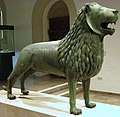 Brunswick Lion, original on display in castle museum.
Brunswick Lion, original on display in castle museum..jpg) Town Hall
Town Hall Veltheimsches Haus (left) and Gildehaus (right)
Veltheimsches Haus (left) and Gildehaus (right) Gewandhaus
Gewandhaus Altstadtmarkt, with Old Town town hall (left) and Stechinelli-Haus
Altstadtmarkt, with Old Town town hall (left) and Stechinelli-Haus.jpg) Church of St. Martin
Church of St. Martin- Altstadt ("Old Town")
- Haus zum Stern on Kohlmarkt
.jpg) Church of St. Catherine and Henry the Lion's Fountain
Church of St. Catherine and Henry the Lion's Fountain- St. Magnus' Church
 Magniviertel
Magniviertel
.jpg) Andreaskirche
Andreaskirche.jpg) Alte Waage
Alte Waage Church of St. Giles
Church of St. Giles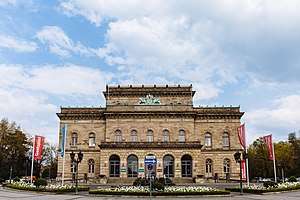 State Theatre
State Theatre Rebuilt exterior of Brunswick Palace
Rebuilt exterior of Brunswick Palace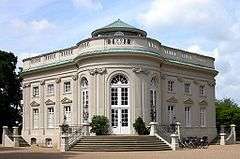 Schloss Richmond (Richmond Palace)
Schloss Richmond (Richmond Palace).jpg) Riddagshausen Abbey
Riddagshausen Abbey
Parks and gardens
Parks and gardens in the city include the botanical garden Botanischer Garten der Technischen Universität Braunschweig, founded in 1840 by Johann Heinrich Blasius, the Bürgerpark, the Löwenwall with an obelisk from 1825, the Prinz-Albrecht-Park, and the Inselwallpark. Other parks and recreation areas are Stadtpark, Westpark, Theaterpark, Museumpark, Heidbergsee, Südsee, Ölpersee, the zoological garden Arche Noah Zoo Braunschweig and the nearby Essehof Zoo.
 Botanischer Garten
Botanischer Garten- Bürgerpark
 Löwenwall
Löwenwall Inselwallpark
Inselwallpark
Politics
Subdivisions
Braunschweig is made up of 19 boroughs (German: Stadtbezirke),[54] which themselves may consist of several quarters (German: Stadtteile)[55] each. The 19 boroughs, with their official numbers, are:
|
|
|
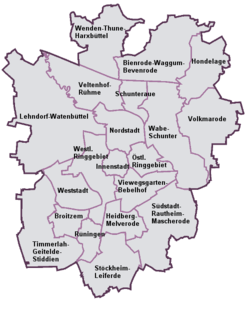 Boroughs of Braunschweig
Boroughs of Braunschweig Stadtteile of Braunschweig
Stadtteile of Braunschweig- Innenstadt
- Östliches Ringgebiet
- Westliches Ringgebiet
 Weststadt
Weststadt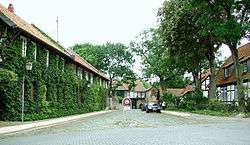 Riddagshausen (Wabe-Schunter-Beberbach)
Riddagshausen (Wabe-Schunter-Beberbach)
1Formed in 2011 out of the former boroughs of Wabe-Schunter and Bienrode-Waggum-Bevenrode.
City council
The council of the city is made up of the fractions of the different parties (54 seats) and the lord mayor, who is elected directly, with one seat.[56] Since 2014, the lord mayor of Braunschweig is Ulrich Markurth (SPD).[57] Results of the most recent local elections on 11 September 2011[56] and 11 September 2016[58] were:
| Party | 2011 % of vote (seats) |
2016 % of vote (seats) |
|---|---|---|
| Christian Democratic Union | 38.2% (21) | 26.2% (14) |
| Social Democratic Party | 29.5% (16) | 33.0% (18) |
| Alliance '90/The Greens | 17.4% (9) | 12.0% (7) |
| Bürgerinitiative Braunschweig | 4.8% (3) | 6.0% (3) |
| Pirate Party | 3.9% (2) | 2.3% (1) |
| The Left | 3.5% (2) | 4.6% (3) |
| Free Democratic Party | 2.1% (1) | 4.5% (2) |
| Alternative for Germany | – (–) | 8.9% (5) |
| Die PARTEI | – (–) | 2.5% (1) |
| Voter turnout: | 49.4% | 55.6% |
International relations
Twin towns/sister cities
Braunschweig is twinned with:[59]
|
Transport

Braunschweig's city centre is mostly a car-free pedestrian zone.
Road
Two main autobahns serve Braunschweig, the A2 (Berlin—Hanover—Dortmund) and the A39 (Salzgitter—Wolfsburg). City roads are generally wide, built after World War II to support the anticipated use of the car. There are several car parks in the city.
Bicycle
Many residents travel around town by bicycle using an extensive system of bicycle-only lanes. The main train station includes a bicycle parking area.
Train
The city is on the main rail line between Frankfurt and Berlin. Deutsche Bahn (German Railways) serves the city with local, inter-city and high-speed InterCityExpress (ICE) trains, with frequent stops at Braunschweig Central Station (German: Braunschweig Hauptbahnhof).[64]
Tram and bus
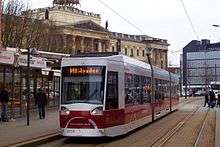
The Braunschweig tramway network is an inexpensive and extensive 35 km (22 mi) long electric tramway system. First opened in 1897, it has been modernized, including a 3.2 km (2.0 mi) extension in 2007.[65] The network has an 1,100 mm (3 ft 7 5⁄16 in) gauge, unique for a European railway or tramway network. However, it is being supplemented in stages by a third rail, to allow future joint working with the 1,435 mm (4 ft 8 1⁄2 in) standard gauge main railway network.
The municipally owned Braunschweiger Verkehrs-AG currently operates five tram lines and several bus lines. The tram lines are:[66]
| Line | from | to |
|---|---|---|
| Tram 1 | Wenden | Stöckheim |
| Tram 2 | Siegfriedviertel | Heidberg |
| Tram 3 | Volkmarode | Weststadt Weserstraße |
| Tram 4 | Radeklint | Helmstedter Straße |
| Tram 5 | Hauptbahnhof | Broitzem |
10 Hauptbahnhof-Rühme
Air
The Braunschweig Airport (BWE / EDVE) is located north of the city at 52°19′N 10°33′E, elev. 295 ft (90 m)
Name
Many other geographical locations around the world are named Brunswick, after the historical English name of Braunschweig. Between 1714 and 1837, the House of Hanover ruled Great Britain in personal union with the Electorate of Hanover. The House of Hanover was formally known as the House of Brunswick-Lüneburg, Hanover line.[67] As a result, many places in the British colonies were named after Brunswick, such as the province of New Brunswick in Canada.[68]
Ironically, the city of Braunschweig was not ruled by the Hanoverians while its name was being given to other Brunswicks around the world. Starting in 1269, the Duchy of Brunswick-Lüneburg underwent a series of divisions and mergers, with parts of the territory being transferred between various branches of the family. The city of Braunschweig went to the senior branch of the house, the Wolfenbüttel line, while Lüneburg eventually ended up with the Hanover line. Although the territory had been split, all branches of the family continued to style themselves as the House of Brunswick-Lüneburg.[67][69] In 1884, the senior branch of the House of Welf became extinct. The Hanover line, being the last surviving line of the family, subsequently held the throne of the Duchy of Brunswick from November 1913 until November 1918.
Government offices
The offices of the Luftfahrt-Bundesamt (LBA, "Federal Aviation Office") and the German Federal Bureau of Aircraft Accident Investigation (BFU) are located in Braunschweig.[70]
Research and science

Braunschweig has been an important industrial area. Today it is known for its University and research institutes, mainly the Johann Heinrich von Thuenen Institute, the Julius Kühn-Institut, and the Institute for Animal Food of the Friedrich Loeffler Institute, until the end of 2007 all part of the Federal Agricultural Research Centre, the German Collection of Microorganisms and Cell Cultures, and the Physikalisch-Technische Bundesanstalt (PTB). The PTB Braunschweig maintains the atomic clock responsible for the DCF77 time signal and the official German time. In 2006 the region of Braunschweig was the most R&D-intensive area in the whole European Economic Area investing 7.1% of its GDP for research & technology.[71] In 2014, the figure had risen to 7.7%, making Braunschweig retain its ranking as the most R&D-intensive region in Germany.[4] Braunschweig was named Germany's City of Science 2007 (German: Stadt der Wissenschaft 2007).[72]
Braunschweig University of Technology (German: Technische Universität Braunschweig) was founded in 1745 and is the oldest member of TU9, an incorporated society of the nine most prestigious, oldest, and largest universities focusing on engineering and technology in Germany. With approximately 18,000 students, Braunschweig University of Technology is the third largest university in Lower Saxony.
Education
Also located in Braunschweig is the Martino-Katharineum (German Wikipedia), a secondary school founded in 1415. It had such famous pupils as Carl Friedrich Gauss, Hoffmann von Fallersleben, Richard Dedekind and Louis Spohr.[73] Since 2004, Braunschweig also has an International School.[74] Other notable secondary schools include the Gymnasium Neue Oberschule, Gymnasium Gaussschule, Gymnasium Kleine Burg (German Wikipedia), Hoffmann-von-Fallersleben-Schule Braunschweig (German Wikipedia), Integrierte Gesamtschule Franzsches Feld (German Wikipedia), and Wilhelm-Gymnasium (German Wikipedia).
Lower Saxony's only university of art, founded in 1963, can be found in Braunschweig, the Hochschule für Bildende Künste Braunschweig (Braunschweig College of Fine Arts).[75] The HBK is an institution of higher artistic and scientific education and offers the opportunity to study for interdisciplinary artistic and scientific qualifications. Additionally, one of the campuses of the Eastphalia University of Applied Sciences (German: Ostfalia Hochschule für angewandte Wissenschaften, formerly Fachhochschule Braunschweig/Wolfenbüttel) was located in the city until 2010.
Economy
In 2015, the German weekly business news magazine Wirtschaftswoche ranked Braunschweig as one of the most dynamic economic spaces in all of Germany.[76]
Braunschweig was one of the centres of the industrialization in Northern Germany. During the 19th and early 20th century the canning and railroad industries and the sugar production were of great importance for Braunschweig's economy,[77] but eventually other branches such as the automotive industry became more important, while especially the canning industry began to vanish from the city after the end of World War II.[78] The defunct truck and bus manufacturer Büssing was headquartered in Braunschweig. Current factories in the city include Volkswagen, Siemens, Bombardier Transportation, and Bosch.
The fashion label NewYorker, the publishing house Westermann Verlag, Nordzucker, Volkswagen Financial Services and Volkswagen Bank have their headquarters in the city as well as the Volkswagen utility vehicle holding. Also two major optical companies were headquartered in Braunschweig: Voigtländer and Rollei.
During the 1980s and early 1990s the computer companies Atari and Commodore International both had branches for development and production within the city.[79][80]
Braunschweig is the home of two piano companies, both known worldwide for the high quality of their instruments: Schimmel and Grotrian-Steinweg. Both companies were founded in the 19th century. Additionally Sandberg Guitars is based in Braunschweig.
Culture
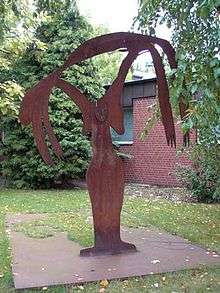
Braunschweig is famous for Till Eulenspiegel, a medieval jester who played many practical jokes on its citizens. It also had many breweries, and still a very peculiar kind of beer is made called Mumme, first quoted in 1390, a malt-extract that was shipped all over the world. Two major breweries still produce in Braunschweig, the Hofbrauhaus Wolters, founded in 1627, and the former Feldschlößchen brewery, founded in 1871, now operated by Oettinger Beer.
Braunschweiger Mettwurst, a soft, spreadable smoked pork sausage, is named after the city. Other traditional local dishes include white asparagus, Braunschweiger Lebkuchen, Braunkohl (a variant of kale served with Bregenwurst), and Uhlen un Apen (Low German for "Owls and Guenons", a pastry).[81][82]
Media
Braunschweig's major local newspaper is the Braunschweiger Zeitung, first published in 1946. Papers formerly published in Braunschweig include the Braunschweigische Anzeigen/Braunschweigische Staatszeitung (1745–1934), the Braunschweigische Landeszeitung (1880–1936) and the Braunschweiger Stadtanzeiger/Braunschweiger Allgemeiner Anzeiger (1886–1941), and the social-democratic Braunschweiger Volksfreund (1871–1933).
Near Braunschweig at Cremlingen-Abbenrode, there is a large medium wave transmitter, which transmits the program of Deutschlandfunk on 756 kHz, the Cremlingen transmitter.
Festivals
Schoduvel, a medieval Northern German form of carnival was celebrated in Braunschweig as early as the 13th century.[83] Since 1979 an annual Rosenmontag parade is held in Braunschweig, the largest in Northern Germany, which is named Schoduvel in honour of the medieval custom.[84]
An annual Weihnachtsmarkt (Christmas market) is held in late November and December on the Burgplatz in the centre of Braunschweig. In 2008 the market had 900,000 visitors.[85]
Museums and galleries

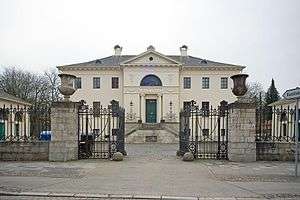
The city's most important museum is the Herzog Anton Ulrich Museum, a well known art museum and the oldest public museum in Germany, founded in 1754. It houses a collection of masters of Western art, including Dürer, Giorgione, Cranach, Holbein, Van Dyck, Vermeer, Rubens, and Rembrandt.
The State Museum of Brunswick (Braunschweigisches Landesmuseum), founded in 1891, houses a permanent collection documenting the history of the Brunswick area ranging from its early history to the present.
The Municipal Museum of Brunswick (Städtisches Museum Braunschweig), founded in 1861, is a museum for art and cultural history, documenting the history of the city of Braunschweig.
The State Natural History Museum is a zoology museum founded in 1754.
Other museums in the city include the Museum of Photography (Museum für Photographie), the Jewish Museum (Jüdisches Museum), the Museum for Agricultural Technology Gut Steinhof, and the Gerstäcker-Museum. Frequent exhibitions of contemporary art are also held by the Art Society of Braunschweig (German: Kunstverein Braunschweig), housed in the Villa Salve Hospes, a classicist villa built between 1805 and 1808.
Music and dance
The Braunschweig Classix Festival was an annual classical music festival. It is the largest promoter of classical music in the region and one of the most prominent music festivals in Lower Saxony.
From 2001 to 2009, and again since 2013, the annual finals of the international breakdance competition Battle of the Year have been held at the Volkswagen Halle in Braunschweig.[86]
Braunschweiger TSC is among the leading competitive formation dance teams in the world and has won multiple World and European championship titles.[87]
Sports

Braunschweig's major local football team is Eintracht Braunschweig. Founded in 1895, Eintracht Braunschweig can look back on a long and chequered history. Eintracht Braunschweig won the German football championship in 1967, and currently plays in the 3. Bundesliga, the third tier of German football, and attracts a large number of supporters. Braunschweig was also arguably the city in which the first ever game of football in Germany took place. The game had been brought to Germany by the local school teacher Konrad Koch, also the first to write down a German version of the rules of football,[nb 1] who organized the first match between pupils from his school Martino-Katharineum in 1874.[88] The 2011 German drama film Lessons of a Dream is based on Koch.
Eintracht Braunschweig also fields a successful women's field hockey team that claimed nine national championship titles between 1965 and 1978. In the past, the club also had first or second tier teams in the sports of ice hockey, field handball, and water polo.
The New Yorker Lions (formerly Braunschweig Lions) are the city's American football team, winning a record number of 12 German Bowl titles, as well as five Eurobowls (a shared record).
The city's professional basketball team, the Basketball Löwen Braunschweig, plays in the Basketball Bundesliga, the highest level in Germany. The Löwen's predecessor SG Braunschweig had previously played in the Bundesliga as well. Eintracht Braunschweig's women's basketball team plays in the 2. Damen-Basketball-Bundesliga, the second tier of women's basketball in Germany.
In handball, MTV Braunschweig, the city's oldest sports club (founded in 1847), plays in the semi-professional 3. Liga.
Other sports clubs from Braunschweig that play or have played at the Bundesliga or 2nd Bundesliga level include Spot Up 89ers (baseball), Braunschweiger THC (field hockey), SV Süd Braunschweig (handball), Rugby-Welfen Braunschweig (rugby union), and USC Braunschweig (volleyball).
Annual sporting events held in Braunschweig include the international equestrian tournament Löwen Classics, Rund um den Elm, Germany's oldest road bicycle race,[89] and the professional tennis tournament Sparkassen Open.
Notable people
Alphabetical list of some notable people associated with Braunschweig:
- Hermann Blumenau (1819–1899), founder of Blumenau, Brazil.[90]
- Johann Joachim Christoph Bode (1731–1793), translator[91]
- Bosse (born 1980), rock musician[92]
- Wilhelm Bracke (1842–1880), one of the founders of the Social Democratic Workers' Party of Germany, predecessor of the Social Democratic Party of Germany.[93]
- Heinrich Büssing (1843–1929), industrialist[94]
- Axel Freiherr von dem Bussche-Streithorst (1919–1993), military officer and member of the German resistance.[95]
- Joachim Heinrich Campe (1746–1818), educator and writer[96]
- Caroline of Brunswick (1768–1821), Queen consort of King George IV of the United Kingdom[97]
- Richard Dedekind (1831–1916), mathematician[98]
- Paul Drude (1863–1906), physicist, developed the Drude model.[99]
- Christine Enghaus (1815–1910), actress[100]
- Johann Joachim Eschenburg (1743–1820), produced the first complete German translation of William Shakespeare's plays.[101]
- Frederick William, Duke of Brunswick-Wolfenbüttel (1771–1815), leader of the Black Brunswickers.[15]
- Carl Friedrich Gauss (1777–1855), mathematician[102]
- Günter Gaus (1929–2004), journalist
- Friedrich Gerstäcker (1816–1872), writer[103]
- Gerhard Glogowski (born 1943), politician[104]
- Otto Grotewohl (1894–1964), Prime minister of the German Democratic Republic[105]
- Otto Harder (1892–1956), German international footballer[106]
- Adolph Henke (1775–1843), physician[107]
- Henry the Lion (1129–1195), Duke of Saxony and Bavaria[108]
- August Hermann (1835–1906), "Braunschweig's Father of Physical Education"[109]
- August Heinrich Hoffmann von Fallersleben (1798–1874), poet and author of Das Lied der Deutschen.[110]
- Ricarda Huch (1864–1947), historian and writer[111]
- Ernst August Friedrich Klingemann (1777–1831), writer[112]
- Gustav Knuth (1901–1987), actor[113]
- Alfred Kubel (1909–1999), politician[114]
- August Lafontaine (1758–1831), author of sentimental didactic novels once immensely popular, born and brought up in the city[115]
- Johann Anton Leisewitz (1752–1806), poet[116]
- Gotthold Ephraim Lessing (1729–1781), writer and philosopher[117]
- Lothar Osterburg (born 1961), printmaker and visual artist[118]
- Otto IV of Brunswick (1175–1218), Holy Roman Emperor[119]
- Bernhard Plockhorst (1825–1907), painter[120]
- Agnes Pockels (1862–1935), chemist[121]
- Wilhelm Raabe (1831–1910), writer[122]
- Friedrich Adolf Riedesel (1738–1800), commander during the American Revolutionary War[123]
- Galka Scheyer (1889–1945), painter[124]
- Dennis Schröder (born 1993), NBA basketball player, currently with the Oklahoma City Thunder.[125]
- Norbert Schultze (1911–2002), composer[126]
- Hans Sommer (1837–1922), composer and mathematician[127]
- Louis Spohr (1784–1859), composer[128]
- Henry E. (1797–1871) and C. F. Theodore Steinway (1825–1889), piano makers[129]
- Ludger Tom Ring the Younger (1522–1584), painter[130]
- Friedrich Georg Weitsch (1758–1828), painter[131]
- Christian Ludewig Theodor Winkelmann (1812–1875), piano maker
- Franz Winter (1861-1930), archaeologist
Notes
- However, Koch's original German version of the rules of football, published in 1875, still resembled Rugby football—the unmodified rules of The Football Association were not commonly used in Germany before the 1900s.
References
- Landesamt für Statistik Niedersachsen, LSN-Online Regionaldatenbank, Tabelle 12411: Fortschreibung des Bevölkerungsstandes, Stand 31. Dezember 2018.
- "Regionales Energiekonzept für den Großraum Braunschweig" (PDF). Zgb.de. Retrieved August 16, 2012.
- "Brunswick (definition 2)". The American Heritage Dictionary (3rd ed.). 1992. p. 245.
- "Research and innovation statistics at regional level". Ec.europa.eu. 2014. Retrieved 2015-07-12.
- H. Mack (1925): "Überblick über die Geschichte der Stadt Braunschweig", in: F. Fuhse (ed.), Vaterländische Geschichten und Denkwürdigkeiten der Lande Braunschweig und Hannover, Band 1: Braunschweig, 3rd edition, Braunschweig: Appelhans Verlag, p. 34.
- "Die Ersterwähnung von 'Brunesguik' und die Gründungssage". Braunschweig.de. Archived from the original on 2013-05-07. Retrieved 2015-07-12.
- Moderhack, Richard (1997). Braunschweiger Stadtgeschichte (in German). Braunschweig: Wagner. pp. 14–15 and 21. ISBN 3-87884-050-0.
- "The Lion City of Brunswick (Braunschweig)". Germany.travel. Archived from the original on 2015-09-24. Retrieved 2015-07-12.
- Moderhack 1997, pp. 50–52
- Camerer; Garzmann; Pingel; Schuegraf (1996). Braunschweiger Stadtlexikon (in German) (4th ed.). p. 66.
- Moderhack 1997, pp. 60–69
- Moderhack 1997, pp. 119–123
- Moderhack 1997, pp. 136–141
- Camerer et al. 1996, p. 215
- Horst-Rüdiger Jarck; Günter Scheel, eds. (1996). Braunschweigisches Biographisches Lexikon – 19. und 20. Jahrhundert (in German). Hannover: Hahnsche Buchhandlung. p. 92. ISBN 3-7752-5838-8.
- Gerhard Schildt (2000): Von der Restauration zur Reichsgründungszeit, in Horst-Rüdiger Jarck / Gerhard Schildt (eds.), Die Braunschweigische Landesgeschichte. Jahrtausendrückblick einer Region, Braunschweig: Appelhans Verlag, pp. 753–766. ISBN 3-930292-28-9.
- Schildt 2000, pp. 772–777
- "Geschichte". Braunschweig.de. Retrieved 2015-07-19.
- E. Oppermann (1911): Landeskunde des Herzogtums Braunschweig. Geschichte und Geographie. Braunschweig: E. Appelhans, p. 64.
- Neubauer, Jürgen / Salewsky, Dieter (1988): 150 Jahre 1. Deutsche Staatseisenbahn Braunschweig-Wolfenbüttel. Braunschweig: Joh. Heinr. Meyer Verlag. ISBN 3-926701-05-6.
- Moderhack 1997, pp. 193–194
- Rother, Bernd (1990). Die Sozialdemokratie im Land Braunschweig 1918 bis 1933 (in German). Bonn: Verlag J. H. W. Dietz Nachf. pp. 27–30. ISBN 3-8012-4016-9.
- Rother 1990, pp. 36–37 and 288
- Rother 1990, pp. 67–72
- Hans-Ulrich Ludewig (2000): Der Erste Weltkrieg und die Revolution (1914–1918/19), in: Horst-Rüdiger Jarck / Gerhard Schildt (eds.), Die Braunschweigische Landesgeschichte. Jahrtausendrückblick einer Region, Braunschweig: Appelhans Verlag, pp. 935–943. ISBN 3-930292-28-9.
- Moderhack 1997, pp. 194–195
- Rother 1990, p. 234
- Rother 1990, p. 244
- Rother 1990, p. 247
- Rother 1990, pp. 247–248
- "Akademie für Jugendführung". Vernetztes-gedaechtnis.de. Retrieved 2015-07-24.
- "Braunschweiger Schloss / SS-Junkerschule". Vernetztes-gedaechtnis.de. Retrieved 2015-07-24.
- Jörg Leuschner (2008): Die Wirtschaft des Braunschweigischen Landes im Dritten Reich (1933–1939), in: Jörg Leuschner / Karl Heinrich Kaufhold / Claudia Märtl (eds.), Die Wirtschafts- und Sozialgeschichte des Braunschweigischen Landes vom Mittelalter bis zur Gegenwart, vol. 3, Hildesheim: Georg Olms Verlag, pp. 468–522. ISBN 978-3-487-13599-1.
- Dieter Lent (2000): Kriegsgeschehen und Verluste im Zweiten Weltkrieg, in: Horst-Rüdiger Jarck / Gerhard Schildt (eds.), Die Braunschweigische Landesgeschichte. Jahrtausendrückblick einer Region, Braunschweig: Appelhans Verlag, p. 1026. ISBN 3-930292-28-9.
- Fiedler, Gudrun; Ludewig, Hans-Ulrich, eds. (2003). Zwangsarbeit und Kriegswirtschaft im Lande Braunschweig 1939–1945 (in German). Braunschweig: Appelhans Verlag. ISBN 3-930292-78-5.
- "Entbindungsheim für Ostarbeiterinnen". Vernetztes-gedaechtnis.de. Retrieved 2015-07-12.
- "Braunschweig: Steeped in History". Deutsche Welle. 2005-03-02. Retrieved 2015-07-17.
- "Dom - Überblick". Vernetztes-gedaechtnis.de. Retrieved 2015-07-12.
- "Braunschweig zwischen Tradition und Moderne". Norddeutscher Rundfunk. 2015-01-29. Retrieved 2015-07-17.
- "Die wechselvolle Geschichte des Braunschweiger Doms". braunschweigerdom.de. Archived from the original on 2015-09-23. Retrieved 2015-07-17.
- "Lower Saxony". Encyclopædia Britannica Online. Retrieved 2015-07-17.
- Gudrun Fiedler / Norman-Mathias Pingel (2008): Vom Nachkriegsboom in den Strukturwandel. Die Wirtschaft der Landes-Region Braunschweig nach 1945, in: Jörg Leuschner / Karl Heinrich Kaufhold / Claudia Märtl (eds.), Die Wirtschafts- und Sozialgeschichte des Braunschweigischen Landes vom Mittelalter bis zur Gegenwart, vol. 3, Hildesheim: Georg Olms Verlag, pp. 586–588. ISBN 978-3-487-13599-1.
- "Stadtchronik Braunschweig". Braunschweig.de. Archived from the original on 2013-09-27. Retrieved 2015-07-12.
- "Die Geschichte des Braunschweiger Schlosses" (in German). braunschweig.de. Retrieved 2015-07-18.
- Justus Herrenberger (1993): Die Baustelle "Alte Waage" in Braunschweig, in: Jahrbuch 1992 der Braunschweigischen Wissenschaftlichen Gesellschaft, Göttingen: Verlag Erich Goltze KG, pp. 29-36.
- "Aktuelle Bevölkerungsdaten" (PDF). braunschweig.de. 2015-12-31. Archived from the original (PDF) on 2016-02-15. Retrieved 2016-02-29.
- Eisenring, Christoph (2016-08-08). "In Deutschlands "Schwarmstädten"". Neue Zürcher Zeitung (in German). Retrieved 2016-10-20.
- "Ausländische Einwohner in Braunschweig nach Nationen" (PDF). braunschweig.de. 2014-09-18. Archived from the original (PDF) on 2015-07-21. Retrieved 2015-07-17.
- "Kohlmarkt (Coal Market)". www.braunschweig.de. Stadt Braunschweig. Retrieved 24 May 2018.
- Stadlmayer, Tina (2012). Wo Braunschweigs erste Bücher standen (in German). Merlin-Verlag. p. 7.
- Arnhold, Elmar (2010). Mittelalterliche Kirchen in Braunschweig (in German). p. 34.
- "Birdlife Data Zone". Birdlife.org. Retrieved 2015-07-12.
- "Archived copy". Archived from the original on 2013-01-07. Retrieved 2012-11-04.CS1 maint: archived copy as title (link)
- Archived April 25, 2015, at the Wayback Machine
- "Stadtteile". Braunschweig.de. Archived from the original on 2013-10-14. Retrieved 2015-07-12.
- "Kommunalwahl 2011 Braunschweig" (PDF) (in German). Braunschweig.de. 2011-10-11. Retrieved 2015-07-12.
- "SPD gewinnt Stichwahlen in Düsseldorf und Braunschweig". Die Zeit (in German). 2014-06-15. Retrieved 2015-07-12.
- "Wahl zum Rat der Stadt Braunschweig. 11. September 2016" (PDF) (in German). Braunschweig.de. 2016-09-16. Retrieved 2016-09-17.
- "Braunschweigs Partner und Freundschaftsstädte" [Braunschweig - Partner and Friendship Cities]. Stadt Braunschweig [City of Braunschweig] (in German). Archived from the original on 2012-12-01. Retrieved 2013-08-07.
- "Bath's Twinning Associations". The Mayor of Bath. Archived from the original on 2011-05-17. Retrieved 2013-07-15.
- "Town Twinning". Bath and North East Somerset Council. Archived from the original on 27 October 2007. Retrieved 12 December 2007.
- Zachert, Uwe; Annica Kunz. "Twin cities". Landeshauptstadt Magdeburg [City of Magdeburg]. Archived from the original on 2012-09-01. Retrieved 2013-08-07.
- "Omaha Sister Cities". Omaha Sister Cities. Retrieved 2015-07-12.
- For a history of rail transport in the state, see Holtge, Dieter. "Braunschweig's Eisenbahnen und Strassenbahnen." (1972).
- "Braunschweig (Germany): New light rail tram line to suburbs reverses Transit Holocaust, February 13, 2007". Light Rail Now. Retrieved April 7, 2011.
- "Tram and bus lines in Braunschweig" (PDF). verkehr-bs.de. Archived from the original (PDF) on 7 March 2016. Retrieved 29 February 2016.
- "Royal Arms of Britain". Heraldica. Retrieved 10 May 2016.
The House of Brunswick Luneburg being one of the most illustrious and most ancient in Europe, the Hanoverian branch having filled for more than a century one of the most distinguished thrones, its possessions being among the most considerable in Germany;
- "New Brunswick - Anthems and Symbols - Canadian Identity". Pch.gc.ca. 2013-08-28. Archived from the original on 2016-05-20. Retrieved 2015-07-12.
- Riedesel, Friedrich Adolf (1868). von Eelking, Max (ed.). Memoirs, and Letters and Journals, of Major General Riedesel During His Residence in America. 1. Translated by Stone, William L. Albany: J. Munsell. p. 29.
I remain ever, Your affectionate Charles, Duke of Brunswick and Lüneburg. Brunswick, February 14, 1776. To Colonel Riedesel.
- Archived February 19, 2012, at the Wayback Machine
- "R&D expenditure in Europe" (PDF). Eurostat. 2006.
- "Stadt der Wissenschaft 2007: Braunschweig" (in German). www.stadt-der-wissenschaft.de. 2007. Archived from the original on 2012-06-08. Retrieved 2012-08-11.
- "Bedeutende Schüler und Lehrer des MK" (in German). Retrieved August 24, 2012.
- "Page:Home". Is.cjd-braunschweig.de. Retrieved 2015-07-12.
- "Startseite – HBK Hochschule für Bildende Künste Braunschweig". Hbk-bs.de. Archived from the original on April 29, 2011. Retrieved April 7, 2011.
- "Städteranking 2015: Dynamik". Wirtschaftswoche. 2015. Retrieved 2016-02-28.
- "Industrieller Aufbruch". Braunschweig.de. Archived from the original on 2012-10-25. Retrieved 2015-07-12.
- "Nachkriegszeit". Braunschweig.de. Archived from the original on 2013-02-10. Retrieved 2015-07-12.
- "Atari kam aus Braunschweig | Wirtschaft | Braunschweiger Zeitung" (in German). Braunschweiger-zeitung.de. 2013-01-21. Retrieved 2015-07-12.
- "Computer aus Zonenrandgebiet:: Commodore bald aus Braunschweig". computerwoche.de. Retrieved 2015-07-12.
- "Typisch köstlich" (in German). Retrieved 3 June 2016.
- "Braunschweig - Kulinarische Spezialitäten vom Mittelalter bis heute" (in German). Archived from the original on 2016-06-29. Retrieved 3 June 2016.
- Søndergaard, Leif. "Carnival is Festival: Dances as Entertainment". Retrieved 8 October 2012.
- "Braunschweiger Karneval "Schoduvel"" (in German). Archived from the original on 31 August 2012. Retrieved 8 October 2012.
- "900 000 Besucher auf dem Weihnachtsmarkt" (in German). Retrieved 8 October 2012.
- "About BOTY". Archived from the original on 25 September 2011. Retrieved 27 August 2012.
- "List of World and European champions". Archived from the original on 23 August 2013. Retrieved 27 August 2012.
- "Die Wiege des Fußballs stand in Braunschweig" (PDF) (in German). Archived from the original (PDF) on 7 December 2010. Retrieved 8 August 2012.
- Hoffmeister, Kurt (2010). Zeitreise durch die Braunschweiger Sportgeschichte: 180 Jahre Turnen und Sport in Braunschweig (in German). p. 43.
- Jarck/Scheel (eds) 1996, pp. 69–70
- Horst-Rüdiger Jarck; et al., eds. (2006). Braunschweigisches Biographisches Lexikon – 8. bis 18. Jahrhundert (in German). Braunschweig: Appelhans Verlag. pp. 89–90. ISBN 3-937664-46-7.
- "Bosse". Munzinger-Archiv. Retrieved 2015-08-01.
- Jarck/Scheel (eds) 1996, pp. 85–86
- Jarck/Scheel (eds) 1996, pp. 110–111
- "Axel Freiherr von dem Bussche-Streithorst". Munzinger-Archiv. Retrieved 2015-08-01.
- Jarck/Scheel (eds) 1996, p. 118
- Jarck/Scheel (eds) 1996, p. 228
- Jarck/Scheel (eds) 1996, p. 137
- Jarck/Scheel (eds) 1996, pp. 147–148
- Knudsen, Hans (1969). "Hebbel, Johanne Louise Christine, geborene Engehausen (Pseudonym Enghaus)". Neue Deutsche Biographie (in German). Retrieved 10 October 2015.
- Jarck/Scheel (eds) 1996, pp. 168–169
- Jarck/Scheel (eds) 1996, pp. 200–201
- Jarck/Scheel (eds.) 1996, pp. 206–207
- Gaschke, Susanne (25 July 1997). "Gerhard Glogowski, Innenminister in Hannover, will Gerhard Schröder beerben, falls der seine Traumkarriere startet". Die Zeit (in German). Retrieved 9 October 2015.
- Jarck/Scheel (eds) 1996, pp. 229–230
- "Otto Harder" (PDF). KZ-Gedenkstätte Neuengamme. Retrieved 2015-08-01.
- Jarck/Scheel (eds) 1996, p. 259
- Jarck et al. (eds) 2006, pp. 317–319
- Jarck/Scheel (eds) 1996, p. 266
- Jarck/Scheel (eds) 1996, pp. 281–282
- Jarck/Scheel (eds) 1996, pp. 293–294
- Jarck/Scheel (eds) 1996, pp. 323–324
- Jarck/Scheel (eds) 1996, p. 329
- "Alfred Kubel" (in German). Niedersächsisches Ministerium für Ernährung, Landwirtschaft und Verbraucherschutz. Archived from the original on 4 March 2016. Retrieved 28 October 2015.
- "Der Lieblingsdichter der Nation ... 124; ZEIT ONLINE". Zeit.de. 1999-07-29. Retrieved 2015-07-12.
- Jarck/Scheel (eds) 1996, p. 375
- Jarck et al. (eds) 2006, pp. 435–437
- Klötzer, Gunter (ed). Germans in America, Stuttgart, Germany: Arnoldsche Art Publishers, 2008, p. 102–3, 220–1. Retrieved August 10, 2020.
- Jarck et al. (eds.) 2006, pp. 539–540
- Jarck/Scheel (eds) 1996, p. 462
- Jarck/Scheel (eds) 1996, pp. 462–63
- Jarck/Scheel (eds) 1996, pp. 473–474
- Jarck/Scheel (eds) 1996, p. 488
- Jarck/Scheel (eds) 1996, pp. 518–519
- Bieg, Peter (2013-01-02). "Basketball-Talent Schröder: Aus der Halfpipe in die Bundesliga". Der Spiegel. Retrieved 2015-08-01.
- Kühn, Volker (2007). "Schultze, Norbert Arnold Wilhelm Richard". Neue Deutsche Biographie (in German). Retrieved 8 October 2015.
- Jarck/Scheel (eds) 1996, p. 573
- Jarck/Scheel (eds) 1996, pp. 580–581
- Jarck/Scheel (eds) 1996, pp. 591–592
- Jarck et al. (eds.) 2006, p. 704
- Jarck/Scheel (eds) 1996, p. 644
Bibliography
- Richard Andree: Braunschweiger Volkskunde. 2nd edition. Vieweg, Braunschweig 1901.
- Reinhard Bein, Ernst-August Roloff (eds.): Der Löwe unterm Hakenkreuz. Reiseführer durch Braunschweig und Umgebung 1930–1945. MatrixMedia Verlag, Göttingen 2010, ISBN 3-93231336-4.
- Luitgard Camerer, Manfred Garzmann, Wolf-Dieter Schuegraf (eds.): Braunschweiger Stadtlexikon. Joh. Heinr. Meyer Verlag, Braunschweig 1992, ISBN 3-926701-14-5.
- Oskar Doering: Braunschweig. E. A. Seemann, Leipzig 1905.
- Hermann Dürre: Geschichte der Stadt Braunschweig im Mittelalter. Grüneberg, Braunschweig 1861.
- Reinhard Dorn: Mittelalterliche Kirchen in Braunschweig. Niemeyer, Hameln 1978, ISBN 3-87585-043-2.
- F. Fuhse (ed.): Vaterländische Geschichten und Denkwürdigkeiten der Lande Braunschweig und Hannover, Band 1: Braunschweig. 3rd edition. Appelhans Verlag, Braunschweig 1925.
- Manfred Garzmann, Wolf-Dieter Schuegraf (eds.): Braunschweiger Stadtlexikon. Ergänzungsband. Joh. Heinr. Meyer Verlag, Braunschweig 1996, ISBN 3-926701-30-7.
- Otto Hohnstein: Braunschweig am Ende des Mittelalters. Ramdohr, Braunschweig 1886.
- Horst-Rüdiger Jarck, Gerhard Schildt (eds.): Die Braunschweigische Landesgeschichte. Jahrtausendrückblick einer Region. 2nd edition. Appelhans Verlag, Braunschweig 2001, ISBN 3-930292-28-9.
- Horst-Rüdiger Jarck, Dieter Lent et al. (eds.): Braunschweigisches Biographisches Lexikon – 8. bis 18. Jahrhundert. Appelhans Verlag, Braunschweig 2006, ISBN 3-937664-46-7.
- Horst-Rüdiger Jarck, Günter Scheel (eds.): Braunschweigisches Biographisches Lexikon – 19. und 20. Jahrhundert. Hahnsche Buchhandlung, Hannover 1996, ISBN 3-7752-5838-8.
- Jörg Leuschner, Karl Heinrich Kaufhold, Claudia Märtl (eds.): Die Wirtschafts- und Sozialgeschichte des Braunschweigischen Landes vom Mittelalter bis zur Gegenwart. 3 vols. Georg Olms Verlag, Hildesheim 2008, ISBN 978-3-487-13599-1.
- Richard Moderhack (ed.): Braunschweigische Landesgeschichte im Überblick. 3rd edition, Braunschweigischer Geschichtsverein, Braunschweig 1979.
- Richard Moderhack: Braunschweiger Stadtgeschichte. Wagner, Braunschweig 1997, ISBN 3-87884-050-0.
- E. Oppermann: Landeskunde des Herzogtums Braunschweig. Geschichte und Geographie. E. Appelhans, Braunschweig 1911.
- Rudolf Prescher: Der Rote Hahn über Braunschweig. Waisenhaus-Buchdruckerei und Verlag, Braunschweig 1955.
- Birte Rogacki-Thiemann: Braunschweig. Eine kleine Stadtgeschichte. Sutton Verlag, Erfurt 2005, ISBN 3-89702-837-9.
- Ernst-August Roloff: Braunschweig und der Staat von Weimar. Waisenhaus-Buchdruckerei und Verlag, Braunschweig 1964.
- Ernst-August Roloff: Wie braun war Braunschweig? Hitler und der Freistaat Braunschweig. Braunschweiger Zeitung, Braunschweig 2003.
- Gerd Spies (ed.): Braunschweig – Das Bild der Stadt in 900 Jahren. Geschichte und Ansichten. 2 vols., Städtisches Museum Braunschweig, Braunschweig 1985.
- Gerd Spies (ed.): Brunswiek 1031 – Braunschweig 1981. Die Stadt Heinrichs des Löwen von den Anfängen bis zur Gegenwart. 2 vols., Städtisches Museum Braunschweig, Braunschweig 1982.
- Werner Spieß: Geschichte der Stadt Braunschweig im Nachmittelalter. Vom Ausgang des Mittelalters bis zum Ende der Stadtfreiheit 1491–1671. 2 vols., Waisenhaus-Buchdruckerei und Verlag, Braunschweig 1966, OCLC 7495150.
- Henning Steinführer, Gerd Biegel (eds.): 1913 – Braunschweig zwischen Monarchie und Moderne. Appelhans Verlag, Braunschweig 2015, ISBN 978-3-944939-12-4.
